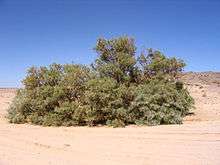Tamarix aphylla
| Tamarix aphylla | |
|---|---|
 | |
| Tamarix aphylla in natural habitat in Algeria | |
| Scientific classification | |
| Kingdom: | Plantae |
| (unranked): | Angiosperms |
| (unranked): | Eudicots |
| (unranked): | Core eudicots |
| Order: | Caryophyllales |
| Family: | Tamaricaceae |
| Genus: | Tamarix |
| Species: | T. aphylla |
| Binomial name | |
| Tamarix aphylla (L.) Karst. | |
| Synonyms | |
|
Tamarix articulata | |
Tamarix aphylla is the largest known species of Tamarix (height: to 18 metres–60 ft). The species has a variety of common names, including Athel tamarisk,[1] Athel tree, Athel pine, and saltcedar. It is an evergreen tree, native across North, East and Central Africa, through the Middle East, and into parts of Western and Southern Asia.
Distribution
Tamarix aphylla is found along watercourses in arid areas. It is very resistant to saline and alkaline soils. [2] The latitudinal range ranges from 35 N to 0 N, and it ranges from Morocco and Algeria in North Africa eastwards to Egypt and south to the Horn of Africa and into Kenya. It is found in the Middle East and the Arabian Peninsula, east through Iran and into India, Pakistan and Afghanistan.[3]
Description
Tamarix aphylla grows as a tree to 18 metres (60 ft) high. The tiny leaves are alternately arranged along the branches, and exude salt, which can form a crusted layer on the surface, and drip onto the ground beneath.[3] The species can reproduce by seed or by suckering.
Uses
Tamarix aphylla has been used as a windbreak and shade tree in agriculture and horticulture for decades, especially in dryer regions such as the western United States and central and western Australia. Due to its higher fire adaptability it can be used as a barrier to fire. Even the dry wood of Tamarix due to its high ash (30–40%) and higher salt content of its foliage makes it difficult to burn. After a fire it usually regrows unless the root crown is also destroyed.[4]
- Australia
Within these regions it has spread, most dramatically and noticeably in central Australia after floods of 1974 along the Finke River in the Northern Territory. Since then it has become a serious weed and invasive species in the Northern Territory and Western Australia. The species had been present for many decades without much spread before this.[5] It tends to use more water than most native plants in Australia, which it outcompetes. It has replaced the indigenous eucalyptus along watercourses in the interior.[5] It has been declared a Weed of National Significance in Australia.[6]
- United States
It is commonly used for windbreaks on the edges of agricultural fields and as a shade tree in the deserts of the Southwestern United States. This species has not naturalized in areas of the United States where it is grown, unlike other species in the Tamarix genus, that are serious invasive species.[7]
History
Most botanists and bible scholars believe that the eshel tree planted by Abraham in the Book of Genesis, was Tamarix aphylla, [8]The 'father of taxonomy' Carolus Linnaeus wrote that its name was derived from the Ancient Greek 'a' "without", and 'phyllon' "leaf".[9]In Urdu and Hindi this tree is called "Farash" (فراش). while in Punjabi it is called "kooan" (کواں). In Baluchi it is called Shakargaaz or Siahgaaz[10]
Chemistry
2,6-Digalloyl glucose and 3,6-digalloyl glucose are gallotannins found in galls of T. aphylla[11]
References
- ↑ "Tamarix aphylla". Natural Resources Conservation Service PLANTS Database. USDA. Retrieved 8 December 2015.
- ↑
- 1 2 CAB International, (2000) Forestry Compendium Global Module. Wallingford, UK: CAB International
- ↑
- 1 2 Griffin, G. F.; Smith, D. M. S.; Morton, S. R.; Allan, G. E.; Masters, K. A.; Preece, N. (1989) Status and implications of the invasion of tamarisk (Tamarix aphylla ) on the Finke River, Northern Territory, Australia. Journal of Environmental Management, 1989, Vol.29, No.4, 297-315
- ↑ "Weeds Australia - Weeds of National Significance - Athel Pine<". www.weeds.org.au. Retrieved 2009-09-29.
- ↑ Forest Service Ecology
- ↑ God as gardener
- ↑ Liddell, Henry George and Robert Scott (1980). A Greek-English Lexicon (Abridged Edition). United Kingdom: Oxford University Press. ISBN 0-19-910207-4.
- ↑
- ↑ Gall polyphenolics of Tamarix aphylla. Mahmoud A.M. Nawwar and Sahar A.M. Hussein, Phytochemistry, July 1994, Volume 36, Issue 4, Pages 1035–1037, doi:10.1016/S0031-9422(00)90486-2